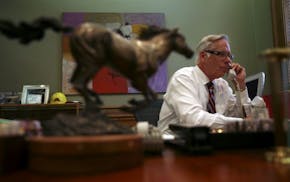How serious are Minnesotans about voting this year? Here's my personal gauge: As the pandemic's pain deepened last week, several friends asked me for advice about how to order a mail-in absentee ballot for the state's August and November elections.
And it's only April.
I took that smattering of queries as a reassuring sign. What I deem a defining Minnesota trait — devotion to participatory democracy — appears to be holding fast in the COVID-19 storm. But it also has me buying Secretary of State Steve Simon's prediction that at least half of this year's ballots are likely to be cast by mail.
State lawmakers ought to take such early interest in absentee voting as a call to action. As much as ever — maybe more than ever — Minnesotans are keen to vote this year. They deserve to do with a safe and orderly process befitting the state with the highest voter turnout in nine of the last 11 presidential elections.
An ability to vote safely and in good order this year will be much enhanced if the Legislature puts an emergency election assistance bill on its must-do list for this COVID-hijacked session. Take it from a leading local elections official.
"We could really use a bill," said Deborah Erickson. As administrative services director for Crow Wing County, Erickson oversees elections in 64 precincts, some in fast-growing Brainerd, some in sparsely populated townships where vote-by-mail has long been the rule. She's also been chair of the elections committee for the Minnesota Association of County Officers for 10 years.
She speaks for many when she pleads with legislators for two kinds of relief — money and rule flexibility.
Federal money is there for the tapping, provided legislators grant their permission. Minnesota is one of the few states that requires legislative approval before federal money can be spent. This state's share of the two most recent congressional appropriations for election administration comes to $14.3 million, with possibly more to come.
It's a situation that gives legislators ample opportunity to tie the release of those funds to their favorite notions about election law — and that means ample opportunity for stubborn partisanship to seize up the works. Last session, $6.6 million was bottled up in the Republican-controlled state Senate for months before finally being released, long after other states had started spending their shares of the 2018 federal Help America Vote Act to shore up cybersecurity.
Erickson explained that this year's untapped federal money — and likely more — will be needed to cope with an increase in absentee and early balloting that swells from 24% in 2018 to more than 50% in this, a higher-turnout presidential election year. Think more temporary staffing; more vote-counting equipment (and/or moving the equipment already on hand); more office space to process absentee ballots in a socially distant way; more postage costs; more public-information expenses.
In-person voting in a pandemic will also cost more, Erickson said. Election judges will need safety equipment, cleaning supplies, even disposable pens. More election judges per precinct will be needed to keep voters safely distant from one another — even as many of the elders who dominate the ranks of the state's election judges decline to serve this year.
That points to the need for flexibility that Erickson also seeks from the Legislature. She envisions setting up larger-facility "vote centers" that serve a number of precincts and in some places might start serving voters well before Election Day, to accommodate a surge of in-person early voting in a safer setting than a courthouse typically affords.
Under current law, polling places must be chosen by Dec. 31 for the following year's election. Changing that date to July 1 would put local officials on firmer legal footing. (Cities have emergency powers that might be invoked to do the same, Minneapolis election officials told me last week. But legal clarity is desirable in an activity that's highly prone to pesky litigation.)
Another plea to legislators: Allow more processing time for absentee ballots. They now can be unsealed and counted no earlier than seven days before an election and no later than 24 hours after the polls close. More time at both ends is in order, given the crush that's likely coming.
Provisions like these are part of a bill that won approval by a DFL-controlled state House finance committee on Thursday. But it advanced on a party-line 11-7 vote, and no similar bill has yet surfaced in the GOP-controlled Senate.
Those are a worrisome signs of gridlock, ones that Minnesotans who expect to vote via absentee ballot this year ought to notice. Apparently — and unfortunately — the propensity to play politics with election administration that was on full display last year has not been suppressed by the novel coronavirus. It may take a howl from Minnesotans who were appalled by what they saw in Wisconsin's April 7 primary to jar legislators out of their pre-pandemic pattern.
Voting has particular appeal during a pandemic, my ballot-seeking friends left me thinking. They complained about the uncomfortable feeling that the virus has taken charge of their lives. Their desire to vote had the quality of a sick person seeking an antidote. They are keen to assert control — to say to COVID-19, "You're not in charge of our government. We the people are."
Legislators ought to be attuned to that sentiment, and should want to reward it.
Lori Sturdevant is a retired Star Tribune editorial writer and columnist. She is at lsturdevant@startribune.com.
Sturdevant: May the pending special session be one that inspires trust

Sturdevant: Threats to cut U research funds put Minnesota's future economy at stake


